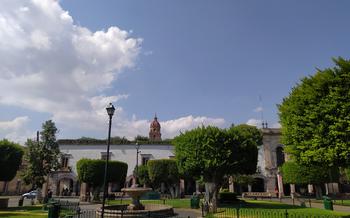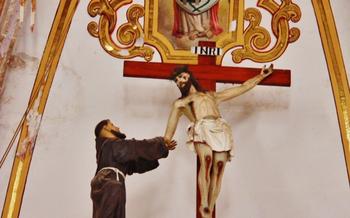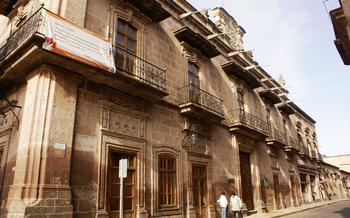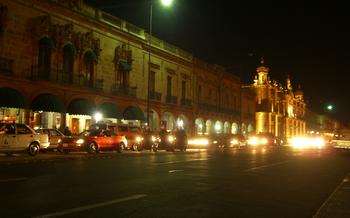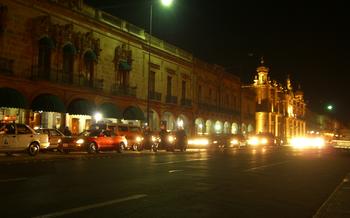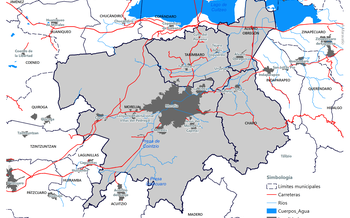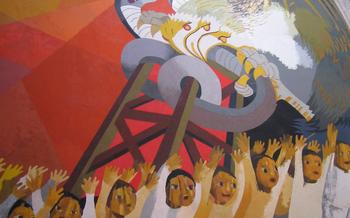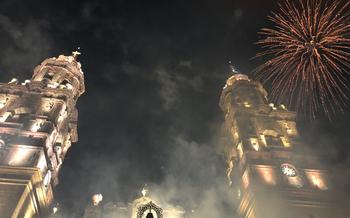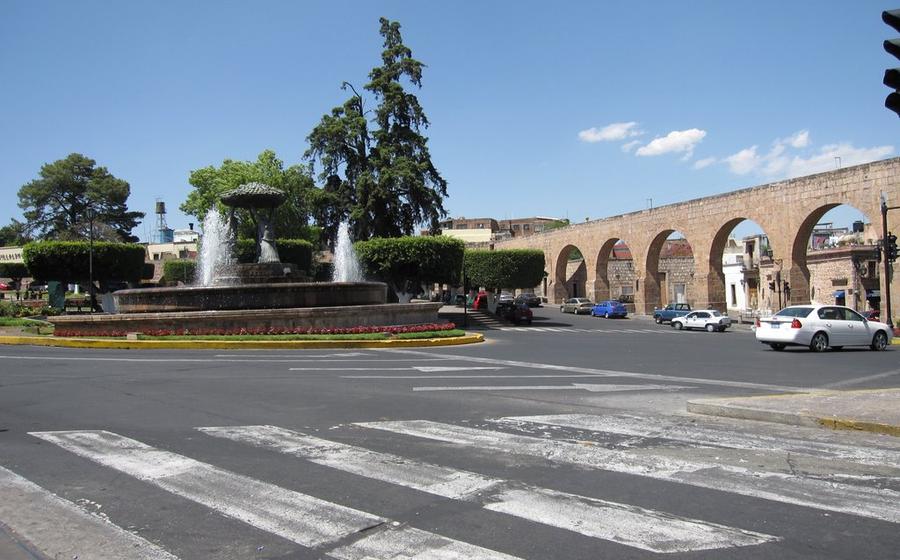
Acueducto de Morelia
- The Acueducto de Morelia: A Historical Marvel
- Location and Accessibility
- Guided Tours and Self-Exploration
- Best Time to Visit the Aqueduct
- Exploring the Surrounding Area
- The Aqueduct as a Photo Opportunity
- Local Traditions and Celebrations
- Sustainability and Conservation Efforts
- Accessibility for Visitors with Disabilities
- Local Cuisine and Restaurants
- Safety and Precautions
- Educational Opportunities
- Insider Tip: Hidden Gems
The Acueducto de Morelia: A Historical Marvel
The Acueduc to the engineering prowess and cultural heritage of Mexico. Built in the late 18th century, this magnificent aqueduct was designed to supply water to the growing city of Morelia. Its construction, initiated by Bishop Manuel Abad y Queipo, involved the collaboration of skilled architects, engineers, and local laborers. The aqueduct's unique design, featuring a series of arches and pillars, not only served its practical purpose but also added to the city's aesthetic appeal, earning it the title of "one of the most beautiful aqueducts in the world." Over the centuries, the Acueducto de Morelia has become a symbol of resilience, withstanding earthquakes and natural disasters, and continues to captivate visitors with its architectural grandeur and historical significance.
Location and Accessibility
The Acueducto de Morelia stands as a majestic landmark in the heart of Morelia, Michoacán, Mexico. Its exact coordinates to pinpoint its location are 1703488, -1019145Reaching the aqueduct is a breeze, thanks to the well-connected public transportation system. Several bus routes, including the Ruta Roja and Ruta Verde, have stops near the site. Alternatively, taxis and rideshare services are readily available for a comfortable journey. For those arriving by car, ample parking spaces are located within walking distance, ensuring a hassle-free visit. The aqueduct's proximity to the city center, just a short stroll away, makes it an easily accessible attraction for visitors exploring Morelia's historical treasures.
Guided Tours and Self-Exploration
The Acueducto de Morelia offers guided tours for visitors who want to delve deeper into its history, cultural significance, and architectural intricacies. These tours are conducted by knowledgeable guides who provide insights and anecdotes about the aqueduct's construction, design, and its impact on the city. Guided tours are available in various languages and can be booked in advance or on-site.
Group tours offer a cost-effective option for travelers, and discounts are available for larger groups. The tours typically cover the history of the aqueduct, its engineering marvels, and the challenges faced during its construction. Visitors can also learn about the cultural significance of the aqueduct and its role in the development of Morelia.
For those who prefer a more independent experience, self-exploration is also an option. Audio guides are available for rent, offering a narrated tour of the aqueduct's highlights. Visitors can also explore at their own pace using maps and guidebooks to learn about the different sections and features of the aqueduct.
Best Time to Visit the Aqueduct
Visiting the Acueducto de Morelia at the right time can enhance your experience. For optimal lighting and atmosphere, the early morning hours offer a golden glow that beautifully illuminates the aqueduct. As the day progresses, the warm afternoon light casts a different charm, creating striking shadows and textures. If you prefer a cooler and less crowded atmosphere, plan your visit during the shoulder months (April-May and September-October) when the weather is pleasant, and the tourist influx is lower. To avoid large crowds, steer clear of peak tourist seasons, typically around major holidays or school breaks. Additionally, keep an eye out for special events or festivals held near the aqueduct, as these can add an extra layer of excitement and cultural immersion to your visit.
Exploring the Surrounding Area
Beyond the awe-inspiring Acueducto de Morelia, the surrounding area beckons with a treasure trove of cultural and historical gems. Just a short stroll away, visitors can immerse themselves in the city's vibrant plazas, bustling markets, and architectural wonders.
Plaza de Armas, the heart of Morelia's historic center, lies within easy reach of the aqueduct. This lively square is adorned with verdant gardens, ornate fountains, and a captivating cathedral, its spires reaching towards the sky. Take a moment to soak in the vibrant atmosphere, watch street performers entertain the crowds, or simply relax on a bench, savoring the city's rhythm.
From the plaza, a labyrinth of cobblestone streets invites exploration. Discover hidden courtyards, stumble upon charming cafes, and browse local shops showcasing traditional crafts and souvenirs. The nearby Mercado de Dulces, a haven for sweet tooths, offers an array of delectable treats, from colorful candies to handmade chocolates. Indulge in the local flavors and take home a taste of Morelia's culinary heritage.
For a more in-depth exploration, consider combining the aqueduct visit with other nearby attractions. The Museo Regional Michoacano, housed in a former convent, showcases a rich collection of pre-Hispanic artifacts, colonial art, and contemporary exhibitions, providing a glimpse into the region's diverse cultural tapestry. The Templo de San Francisco, with its intricate facade and Baroque interior, stands as a testament to Morelia's architectural prowess.
As the sun begins to set, the aqueduct and its surroundings transform into a magical spectacle. The golden hues of twilight bathe the city in a warm glow, casting long shadows that enhance the architectural details. Take advantage of this enchanting atmosphere to capture some truly unforgettable photographs. With so much to see and experience, the area surrounding the Acueducto de Morelia promises an unforgettable journey through history, culture, and beauty.
The Aqueduct as a Photo Opportunity
The Acueducto de Morelia is not just a historical marvel but also a visual masterpiece that attracts photographers from around the world. With its towering arches, intricate details, and stunning backdrop, the aqueduct offers endless opportunities for capturing breathtaking images.
Whether you're a professional photographer or simply an enthusiastic hobbyist, here are some tips to help you make the most of your photo session:
-
Early mornings and late afternoons: The golden hours of dawn and dusk provide the most flattering light for photography, casting a warm glow onto the aqueduct's facade.
-
Panoramic views: For a dramatic perspective, head to the nearby Cerro del Quinceo viewpoint. This elevated spot offers stunning vistas of the aqueduct stretching across the city skyline.
-
Creative angles: Experiment with different angles to add depth and interest to your shots. Try shooting from below to emphasize the aqueduct's grandeur or from a side angle to capture its graceful curves.
-
Editing tips: To enhance your photos, consider using editing software to adjust the contrast, saturation, and white balance. Experiment with filters or presets to create a unique and eye-catching look.
Local Traditions and Celebrations
Beyond its architectural grandeur, the Acueducto de Morelia is deeply woven into the cultural tapestry of the city. It has witnessed countless celebrations, festivals, and traditions over the centuries. During the annual Fiestas Patrias, the aqueduct serves as a vibrant backdrop for parades, live music, and traditional dances. The Festival Internacional de Cine de Morelia, a renowned film festival, often incorporates the aqueduct as a stunning backdrop for outdoor screenings and events. Locals and tourists alike gather to enjoy these cultural extravaganzas, creating a lively atmosphere around this historic landmark.
One of the most enchanting traditions associated with the aqueduct is the "Leyenda de la Tarasca." According to this local legend, a mythical creature known as the Tarasca once terrorized the region. The brave princess, Matlali, armed with her courage and wit, defeated the Tarasca and saved her people. Every year, during the Festival de la Tarasca, a grand procession takes place, featuring a giant puppet representing the mythical creature. Accompanied by music, dance, and colorful costumes, the procession winds its way through the streets, culminating at the aqueduct, where the Tarasca is symbolically defeated once again.
These cultural events and traditions bring the Acueducto de Morelia to life, showcasing its significance as a symbol of the city's heritage and community spirit. Embracing these local celebrations offers visitors a unique opportunity to immerse themselves in the vibrant culture of Morelia and create lasting memories.
Sustainability and Conservation Efforts
The Acueducto de Morelia stands as a testament to the ingenuity and craftsmanship of its creators. Preserving this architectural marvel and maintaining its historical integrity are essential for future generations to appreciate its grandeur. The local authorities and conservation organizations have implemented several initiatives to ensure the sustainability and protection of the aqueduct. Regular maintenance and restoration work are carried out to address any signs of wear and tear, ensuring its structural stability and longevity.
Promoting responsible tourism plays a crucial role in preserving the aqueduct. Visitors are encouraged to adopt sustainable practices, such as minimizing waste and respecting the surrounding environment. Guided tours often incorporate information about the aqueduct's history and cultural significance, fostering a sense of appreciation and respect among visitors. By raising awareness and educating the public about the importance of heritage preservation, we can collectively contribute to the longevity of this iconic landmark.
Accessibility for Visitors with Disabilities
The Acueducto de Morelia is committed to ensuring accessibility and inclusivity for all visitors, regardless of their physical abilities. The site features wheelchair ramps and accessible walkways that allow visitors with mobility challenges to navigate the area comfortably. Designated parking spaces are available close to the aqueduct for disabled visitors, providing convenient access to the site. Additionally, Braille signage or audio guides are available for visually impaired visitors, enhancing their experience and understanding of the aqueduct's history and significance. The staff at the site is trained to provide assistance or accommodations for visitors with special needs, ensuring that everyone has an enjoyable and enriching visit to the Acueducto de Morelia.
Local Cuisine and Restaurants
When visiting the Acueducto de Morelia, immerse yourself in the vibrant culinary scene of the region. Step into one of the many restaurants nestled near the aqueduct and savor the authentic flavors of Mexican cuisine. From traditional dishes to modern interpretations, there's a culinary adventure waiting for every palate.
For an authentic Mexican experience, try the local specialty, carnitas, a slow-cooked pork dish served with fresh tortillas, salsa, and guacamole. Indulge in the richness of pozole, a hearty broth with tender pork or chicken, hominy, and a variety of toppings. Don't miss out on enchiladas, corn tortillas filled with cheese and your choice of meat, smothered in a flavorful sauce.
For vegetarians and vegans, there are plenty of delicious options to satisfy your cravings. Sample the enchiladas vegetarianas, filled with grilled vegetables and topped with a tangy tomato sauce. Enjoy the freshness of sopes, thick corn tortillas topped with refried beans, vegetables, and salsa. And for a healthy and flavorful treat, try the esquites, grilled corn kernels tossed with mayonnaise, chili powder, and cotija cheese.
To enhance your culinary experience, pair your meal with a refreshing agua fresca, a traditional Mexican fruit-based drink made with fresh fruit, water, and a touch of sugar. Choose from a variety of flavors like hibiscus, tamarind, or horchata, a creamy rice-based beverage. And for a sweet ending, indulge in the traditional churros, crispy fried pastries served with a warm chocolate dipping sauce.
When selecting a restaurant, look for establishments that are clean and reputable. Ask your hotel concierge or a local resident for recommendations, and always check online reviews to ensure a positive dining experience.
Safety and Precautions
When exploring the Acueducto de Morelia, it is essential to prioritize personal safety and take necessary precautions to ensure a pleasant and secure visit. Here are some guidelines to keep in mind:
-
General Safety: As with any tourist destination, maintaining general awareness and avoiding isolated or poorly lit areas is advisable. Stick to well-populated paths and avoid wandering off alone, especially during late evening hours.
-
Avoiding Scams: Unfortunately, tourist attractions often attract individuals looking to take advantage of visitors. Be wary of unsolicited offers for tours or services, and always verify prices and legitimacy before engaging with anyone.
-
Protecting Valuables: Keep your personal belongings close and avoid leaving valuables unattended. It's best to carry only essential items and consider using a money belt or secure bag to safeguard your belongings.
-
Emergency Preparedness: Familiarize yourself with the location of the nearest police station or tourist information center. Keep emergency contact numbers handy and ensure your phone is fully charged before venturing out.
By following these simple precautions, you can fully immerse yourself in the beauty of the Acueducto de Morelia while ensuring your safety and well-being.
Educational Opportunities
The Acueducto de Morelia offers a wealth of educational opportunities for visitors of all ages. Interactive exhibits and displays provide insights into the history, construction, and cultural significance of the aqueduct. Visitors can learn about the engineering marvels involved in its creation, the role it played in the development of Morelia, and the unique architectural features that make it stand out.
For those seeking a deeper dive into the aqueduct's significance, workshops and seminars are occasionally organized, covering topics such as its construction techniques, architectural styles, and historical context. These sessions are led by experts in the field and offer a chance for participants to engage in discussions, ask questions, and gain a comprehensive understanding of the aqueduct.
Families with children can take advantage of interactive activities designed to make learning about the aqueduct fun and engaging. These activities may include quizzes, games, and hands-on experiences that allow children to explore the aqueduct's history and architecture in a playful way.
Moreover, the aqueduct presents a unique opportunity for visitors to contribute to its preservation and conservation efforts. Volunteering opportunities are available for individuals or groups who are passionate about heritage conservation and wish to make a positive impact. Volunteers can participate in activities such as cleaning, maintenance, and restoration projects, gaining valuable hands-on experience while contributing to the preservation of this iconic landmark.
Insider Tip: Hidden Gems
Venture beyond the main tourist routes to discover hidden gems that offer a unique perspective of the Acueducto de Morelia. Explore the lesser-known viewpoints along the aqueduct's path, where you can capture breathtaking panoramic shots and escape the crowds. One such spot is the Mirador del Cerro del Quinceo, a hilltop viewpoint that offers stunning vistas of the aqueduct against the backdrop of the city and the surrounding mountains.
Uncover the aqueduct's significance through local festivals and events that celebrate its cultural heritage. Participate in the annual Festival del Acueducto, a vibrant celebration featuring traditional music, dance, and art exhibitions that showcase the aqueduct's role in Morelia's identity. This insider tip will allow you to experience the aqueduct beyond the typical tourist trail, creating lasting memories of your visit to this remarkable historical landmark.

